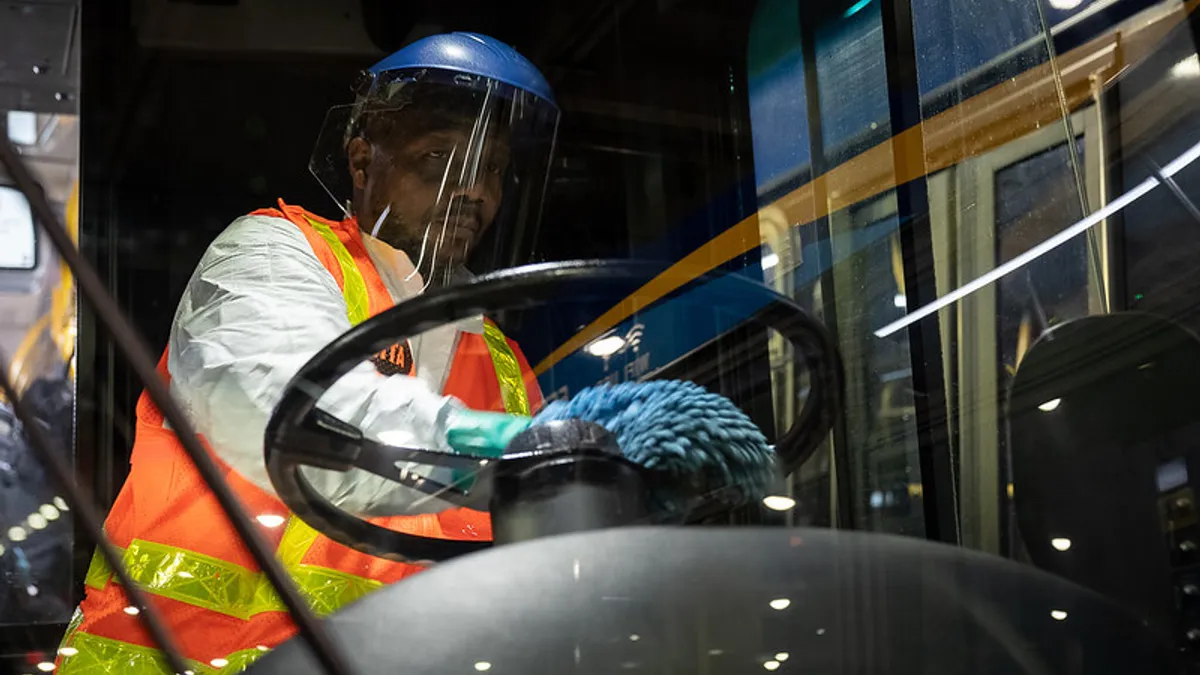Transit agencies face an uncertain and challenging future as cities lift their shelter-in-place orders, but there could be an opportunity to partner with their one-time rivals: ride-hailing companies.
In a new white paper, analysts at the Perkins and Will Mobility Lab say transit agencies should consider partnering with transportation network companies (TNCs) as they develop strategies to limit the spread of COVID-19, while also resuming service for commuters.
COVID-19 restrictions could mean that transit networks will need to run more buses more frequently on busy routes, for example, to ensure passengers can distance from each other while commuting. Under that scenario, TNCs "could alleviate the financial burden on public transit systems by providing transit riders with a more frequent and personalized service," the white paper says, especially on less trafficked routes.
Gerry Tierney, associate principal of Perkins and Will and author of the white paper, said the restrictions of the pandemic meant that agencies will have to "take all the tools in your toolbox and use them efficiently for the right operations." For low-density neighborhoods where buses might often be empty, ride-hailing services offer a "more nuanced and bespoke kind of transit where it’s appropriate," he said.
Shelter-in-place orders slashed ridership for networks already struggling with tight budgets and declining use. As cities lift those orders and travel slowly resumes, bus and train operators will have to cope with new restrictions to minimize crowding, while also accommodating more frequent cleaning of vehicles.
Washington Metropolitan Area Transit Authority has said it will try to limit ridership to ensure six feet of distancing between passengers, which would mean about 20 people to a rail car. Meanwhile, New York’s Metropolitan Transportation Authority is expanding bus service to help riders avoid crowds, and is shutting down subway service between 1 a.m. and 5 a.m. to clean vehicles.
The Centers for Disease Control and Prevention (CDC) has encouraged employers to offer incentives for commuters to use transportation modes that minimize close contact, like biking, walking or driving. (The agency did back off a previous recommendation that encouraged commuters to only drive alone.) That will require a mix of modes that allow for proper distancing, said Tierney.
"We need to allow transit to do what it does best, and not force it to do things that it wasn’t set up for," Tierney said.
An initially tense relationship — fueled by concerns from transit agencies that ride-hailing companies were siphoning off riders while creating new congestion in cities — has started to thaw and give way to a handful of pilots for how TNCs and transit can work together. While companies like Uber and Lyft have started offering transit directions and even integrating ticketing in some cities, other agencies have looked to TNCs as a first-mile, last-mile solution, or to replace bus service in less dense areas or non-commuting hours.
The City of Monrovia, CA, for example, started offering discounted Lyft and Lime Bike rides in 2018 to help riders access the LA Metro light rail station and as an alternative to its Dial-a-Ride program. The Livermore Amador Valley Transit Authority in the Bay Area suburb of Dublin provides discounted trips with ride-hailing companies.
Cap Metro in Austin, TX announced a partnership in 2019 with Via to bring on-demand shared van rides to five neighborhoods, replacing existing bus routes. Now the company works with more than 90 agencies across the globe. Via CEO and co-founder Daniel Ramot said the COVID-19 pandemic has accelerated discussions about how transit agencies can shake up their existing route networks and could lead to permanent changes.
"We used to say that demand for transportation can change minute-by-minute and then we see demographics and demand change year-over-year," Ramot told Smart Cities Dive. "Now what we’re seeing during the pandemic is that everything is condensed, the demand is different week to week. There’s a much greater need for flexibility, to use technology to rethink the network."
Some cities have turned to Via and other TNCs to move essential workers while transit service is limited. New York City has offered a free trip in a for-hire vehicle after subway closures if a bus trip is too long or inconvenient. Johnson County, KS, which is served by Kansas City’s RideKC, announced in May that it was expanding a pilot to offer flexible ride-sharing for low-ridership routes.
But with concerns about the spread of the virus, agencies will have to take extra steps to ensure that vehicles are safe and that riders feel comfortable sharing a space with other riders or drivers. Tierney suggested that transit agencies could be explicit that any partners meet the same cleaning standards for their own buses and trains.
Art Guzzetti, vice president of mobility initiatives and policy for the American Public Transportation Association, said the effort to integrate all forms of mobility under one umbrella was already moving ahead, but COVID-19 offered a "chance to re-examine everything in all dimensions."
"The evolution to Mobility-as-a-Service was a strong priority before the pandemic started and that’s going to continue with transit as the backbone," Guzzetti said. "COVID is just another chapter in that story."
To keep up with all of our coverage on how the new coronavirus is impacting U.S. cities, visit our daily tracker.



















